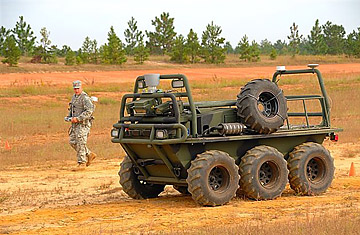
The Squad Mission Support System (SMSS), which will likely head to Afghanistan for testing next year, can be driven by a driver, tele-operated or remote-controlled
Is the day approaching when the U.S. military can deploy a robot that can drive itself around a corner, use senors to detect an enemy fighter on the move and destroy targets instantly with missiles and machine guns — all without human intervention? The Pentagon thinks the day may be imminent, and it wants to ensure that its technology doesn't get ahead of military doctrine. It wants to be certain that there is always a human making decisions regarding the use of lethal force.
With some estimates of armed robots with so-called autonomous navigation systems less than five years away, the U.S. Army is drafting a white paper to set guidelines for their use. "This is a concept paper to think about war-fighting outcomes and what robotics will do for soldiers," says U.S. Lieut. General Michael Vane, who directs the Army Capabilities Integration Center in Fort Monroe, Va. "I am starting out with the idea of having a technology-enabled human. [But] we might someday come up with [separate] IT doctrine and robot doctrine." He reiterates that "we want to make the people or humans in charge under command and control in a 'whole of government' approach." The white paper will be finished in the coming weeks, Army officials say. (See the most memorable movie robots.)
Thousands of 30-lb. backpackable remote-controlled or "tele-operated" robots with infrared and electro-optical cameras are already clearing caves, buildings and other potential enemy locations in Iraq and Afghanistan. But two new robots are at the front of the autonomous revolution: the MULE and the SMSS. (See a gallery of robots.)
Computer algorithms are advancing to the point where prototype robots like the Army's Multi-Utility Logistics Equipment (MULE) vehicle are able to cross barriers and navigate obstacles without human guidance. The MULE — a 14-ft.-long, six-wheeled robot equipped with a range of navigational sensors slated to deploy with U.S. forces 2015 — will eventually carry Javelin antitank missiles and M240 machine guns. The MULE could well carry supplies and conduct reconnaissance missions for light infantry units in difficult terrain like Afghanistan. It is programmed with onboard computers so that the vehicle can find its own way around corners, up mountains and over obstacles.
So far, the MULE has crossed over highway barriers in New Jersey by itself in testing. In a few years, the robot will be able to drive itself with onboard computers, navigate its way around obstacles while using sensors to beam back images of the surrounding terrain and, ultimately, fire deadly weapons on targets identified by the sensors. This last portion of the MULE's abilities — namely the capability of using lethal force by itself upon enemies — is of particular concern for the Army.
Meanwhile, the mountainous terrain and high altitudes of Afghanistan have led the Army to increasingly emphasize rapid delivery of anything that can lighten a soldier's load. As a result, the U.S. Army Infantry Center at Fort Benning, Ga., is experimenting with a 4,000-lb, six-wheeled semiautonomous, supply-carrying robot vehicle called the Squad Mission Support System (SMSS), which will likely head to the mountains of Afghanistan for testing sometime next year.
The SMSS can be driven with a driver, tele-operated or remote-controlled, or be preprogrammed to go to specific, predetermined locations. During a November Army war-fighting experiment, the SMSS was able to find its way through rugged terrain during both day and nighttime operations. "We provide supervised autonomy," explains Don Nimblett, a business-development manager with SMSS maker Lockheed Martin. "You could [instruct it to go] to a point, and it would find its way to that location on the earth's surface. It is a very mobile vehicle. At one point the soldiers ran it into a ravine, and the vehicle was able to climb back out with no trouble."
Of course, there are some experts who are less sanguine about the capabilities of "autonomous" robots than the Pentagon. Says Daniel Goure, vice president of the Lexington Institute, a public-policy think tank: "It is tough enough for us to train human soldiers to distinguish between combatants and noncombatants on the battlefield. It is much more difficult to write software that does that." Goure adds, "How does a robot distinguish between a friendly ally, a local civilian or a hostile fighter? The distinguishing characteristics are for the most part very small. What are the distinguishing characteristics between an enemy column and a parade of religious pilgrims going to a holy festival? If there is a bunch of people waving banners in trucks driving toward you, is that something you want a machine to decide?"
All the more reason for the Pentagon to make sure humans can still climb into the driver's seat — and tell the robot who's boss.
